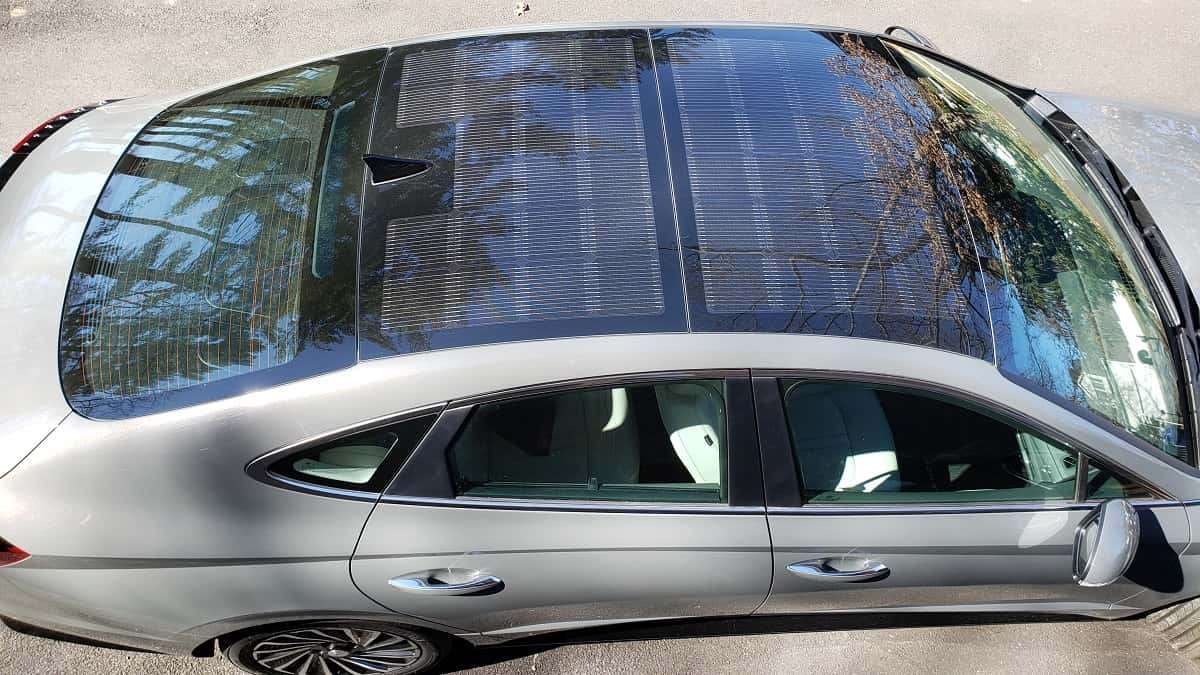Green vehicles use every possible technology to reduce our liquid-fuel usage. Modern hybrids, like the Hyundai Sonata Limited we tested this week, reduce your carbon footprint, reduce your fuel costs to near plug-in levels, and extend the EV-only range the vehicle can travel. The most apparent green tech found on the Sonata is on its roof.
Hyundai's Solar Roof Range Added Per Day
Hyundai’s solar roof can add about 2 miles per day to your electric driving. Like many hybrids, the Hyundai Sonata can operate using only its electric motors for short periods of time on a typical trip. When moving slowly around a parking lot or when cruising at moderate speeds. During our testing, there were many instances where we were moving along for many minutes without the gas engine on.
Hyundai’s solar roof may seem like a novelty at first glance, but is it? Not to our way of thinking. Today’s automobiles commonly last 20 years. I own a 14-year old vehicle in perfect condition myself and plan to use it for many more years. That got me thinking; “How many EV-travelled miles will the solar roof add to the Sonata over its lifetime?
How Much Range Does a Solar Vehicle Roof Add?
The math is easy. 2 miles per day, times 365 days per year, times twenty years. Let’s skip the leap years and call it 14,600 miles in total. Or about 1/5th of the total miles the vehicle will travel over that time. 14,000 EV miles sounds pretty good to this green vehicle fan. No Rivian has ever taken a customer that far on electricity. Nor a Bollinger vehicle, nor an Aptera vehicle. Yet, all three earn splashy headlines on green vehicle publications daily.
Solar Roof Energy Cost Savings
The savings in fuel are also pretty easy to calculate. The U.S. Department of Transportation says that the average driver covers about 13,500 miles in a year. We also know the EPA-Estimated annual fuel cost for the Sonata in today’s low gas prices is $900. So, if the roof costs less than $900, it is a financial benefit to the driver. Panoramic moonroofs found on many green vehicles cost a lot more than that and do nothing to increase efficiency.
Here’s another way to think about 14,000 miles of EV range. It is enough to carry you from New York to San Francisco four times. Or to carry you round trip from Boston to Naples Florida five times. Is this a meaningless number of miles? Not to retired folks who make that drive every year.
Related Story: Only Half of Green Vehicle Owners Want a Vehicle With a Solar Roof
It seems like any person who owns solar roofing on a home would immediately see the value in a solar roof on a green vehicle. That space faces the sun as long as you park it outside on a clear day. Why waste the gas-free miles?
John Goreham is a long-time New England Motor Press Association member and recovering engineer. Following his engineering program, John also completed a marketing program at Northeastern University and worked with automotive component manufacturers. In addition to Torque News, John's work has appeared in print in dozens of American newspapers and he provides reviews to many vehicle shopping sites. You can follow John on Twitter, and view his credentials at Linkedin






Comments
Something must be pretty
Permalink
Something must be pretty inefficient in the Sonata to only get 2 miles a day from it's roof's solar panels. The free solar panels on just the roof of the Aptera will gain an extra 9 miles a day (max), and the full solar package gets 40 miles+ per day in sunny climates. The Rivian and Bollenger may not do better than the Sonata because they are relatively big, blunt, and heavy beasts. Toyota's Prius Prime prototype was supposed to provide 27 miles of EV range from the solar panels, so the solution to making a dent in EV range with solar is the vehicle's efficiency.
Interested in purchasing a
Permalink
Interested in purchasing a new Hyundai.
But, not sure which model will serve me best.